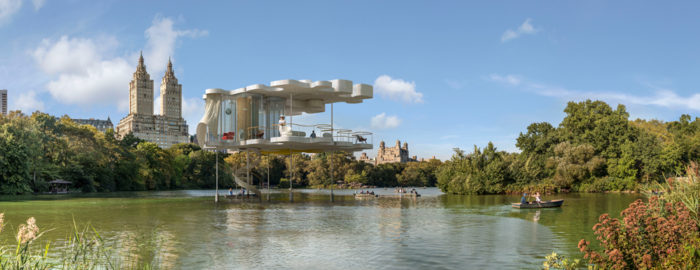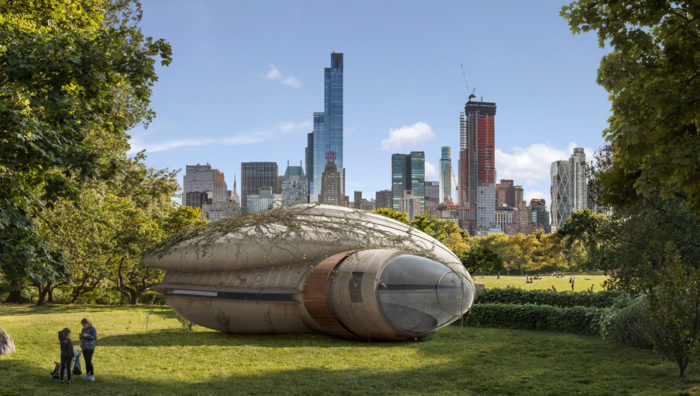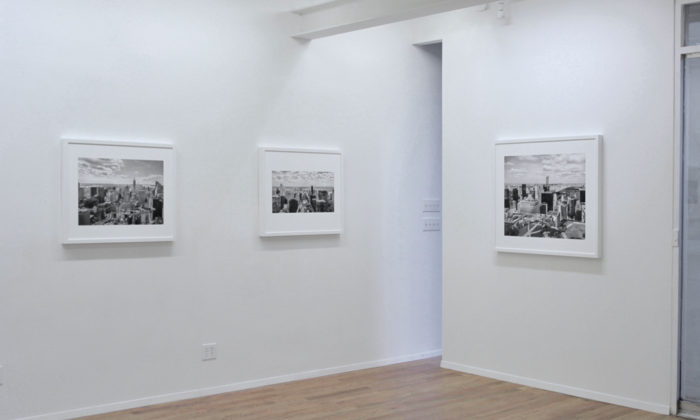
Step foot inside Galerie Richard, through August 27th, and you will find yourself standing between two series of works from Spanish artist Dionisio González. On the left in color, scenes of Central Park featuring imagined, futuristic structures—refuges for selected notables of society—which have been imbedded into the park’s existing landscape. On the right in black and white, aerial views of the built-up urban landscape beyond, to which grand, connective structures have been added—running between and atop Manhattan’s towering skyscrapers. Together, with the powers of 3-D imaging and inspiration gained from such writings as Robert Smithson’s essay, “Frederick Law Olmsted and the Dialectical Landscape,” these two series, Thinking Central Park and Dialectical Landscape, make up various virtual visions of New York City.

The one exception to Dialectical Landscape’s aerial viewpoint is Dialectical Landscape 7 (2017), which can be seen as a piece which somewhat straddles and connects the two series—both visually and conceptually. It is a street view of New York’s historic building, The Dakota, to which have been added large pathways or arches in the sky that jut southward from the building’s roof toward downtown Manhattan and the southern sections of Central Park. In some ways dialectically opposed to the individually tailored, futuristic safe zones featured in Thinking Central Park, The Dakota building has long been home to many celebrities throughout the years, including John Lennon who was tragically murdered under the building’s front archway. Across Central Park West, outside the piece’s viewpoint, down the street which can be seen on the right, lie the internationally known Imagine tiles, which serve as a memorial to Lennon and his commitment to peace and togetherness.
At the time of his arrest, John Lennon’s assassin was found with a copy of J.D. Salinger’s classic novel Catcher in the Rye, which describes a rebellious, disconnected protagonist whose interests include Central Park, one of the few places where he finds some happiness with another person. Upper West Side native and noted recluse later in life, it is no great coincidence that Salinger’s Refuge (2017), featuring a lightly foliage-covered and hedged in, bullet-shaped structure, is included in Thinking Central Park—perhaps speaking to both Salinger’s place in the park’s dialectic, as well as the vast park’s unique ability to provide both public and private space. One might imagine Salinger stepping out of his Central Park pod some days to seek a little fresh air and some company.

Central Park’s visionary chief architect, Frederick Law Olmsted, is recognized with Olmsted’s Eye (2017) in which three structures have been inserted onto what appears to be the park’s Sheep’s Meadow against the backdrop of New York’s cityscape. The construction on the left side of the piece resembles a conglomeration of pipes and drills evoking the physical engineering and development of the park. The structure to the right has long, smooth lines and large window panes bringing to mind finished views. At the center of the lawn stands the smallest structure, which resembles an eye looking out onto the park. Olmsted understood his architectural landscaping as art, careful composition that he excavated from the land to create an overall effect that satisfied inherent human needs. He envisioned a dialogue between the park and the posh buildings that would crop up around it, seeing both as grand sections of the city to be consumed in a spirit of community. González’s inserted structures seem to add a third element to the dialogue, playing against a public space by inserting private architectural structures for a select few which rest not outside the park, but rather inside it.
In 1940, noted dialectical philosopher and literary critic Walter Benjamin hoped to flee Nazi persecution and find refuge in the United States. When it became clear that this would not be possible, he committed suicide. W. Benjamin’s Cabin (2017) seems to imagine an alternate reality in which Benjamin makes his escape. His three dimensional star-shaped cabin reads like a vessel that has alighted on the grasses of Central Park. It may be noted here that Olmsted was an outspoken critic of slavery and could easily be imagined offering Benjamin refuge on the lawn himself. The poles which extend from the cabin to the grassy dirt give it a pitched tent feel as well, bringing to mind the temporary dwellings of both refugees and campers. A slightly worn away stamp on one corner of the cabin reads, “Lo Fidelity Allstars, Madison Square Garden, April 12.” April 12th—coincidentally the start date of the American Civil War—was the release date of the British band’s album Don’t Be Afraid of Love. Together the details of this piece spark dialogue about war and humanity, while also recalling the British musical invasion that followed John Lennon and The Beatles across the pond, bringing such liberating songs and notions as “All You Need is Love.”

If you are familiar with pop icon Lady Gaga’s costumes and set designs you may see similarities between them and the futuristic structures featured in Thinking Central Park. For example, the angular, throne-like piece which can be seen in the video for “Born this Way” bears a resemblance to Benjamin’s Cabin as both works address concepts of love, hate, and persecution. J.D. Salinger’s refuge loosely resembles the pods from which a passion seeking Gaga and Co. emerge in the video for “Bad Romance.” And it is to Gaga that the remaining piece of the Thinking Central Park Series is dedicated. Lady Gaga’s Belvedere (2017) is a play on Central Park’s real Belvedere Castle. However, basically designed as one big balcony, the structure it features is barely fortified. Upon first glance, the lake into which it has been inserted might be seen as a moat or waters that the structure aims to evade, but, upon closer look, it boasts a spiral staircase which the surrounding boaters might just as easily ascend or descend as the lady of the house herself. Like The Dakota’s archway, Lady Gaga’s castle leaves its star inhabitant open to the surrounding public, accessible to fans and foes. And perhaps we ask ourselves: Dare we earth dwellers try to love again? Or might it be better to escape, above it all, up onto the network in the sky afforded to us in Dialectical Landscape?
Dionisio González: Thinking Central Park and Dialectical Landscape
July 5 – August 27, 2017
Galerie Richard
121 Orchard Street
New York, NY 10002






Hi there,I read your new stuff named “Dionisio González’s Thinking Central Park and Dialectical Landscape at Galerie Richard – Arte Fuse contemporary art” like every week.Your story-telling style is witty, keep it up! And you can look our website about free proxy.